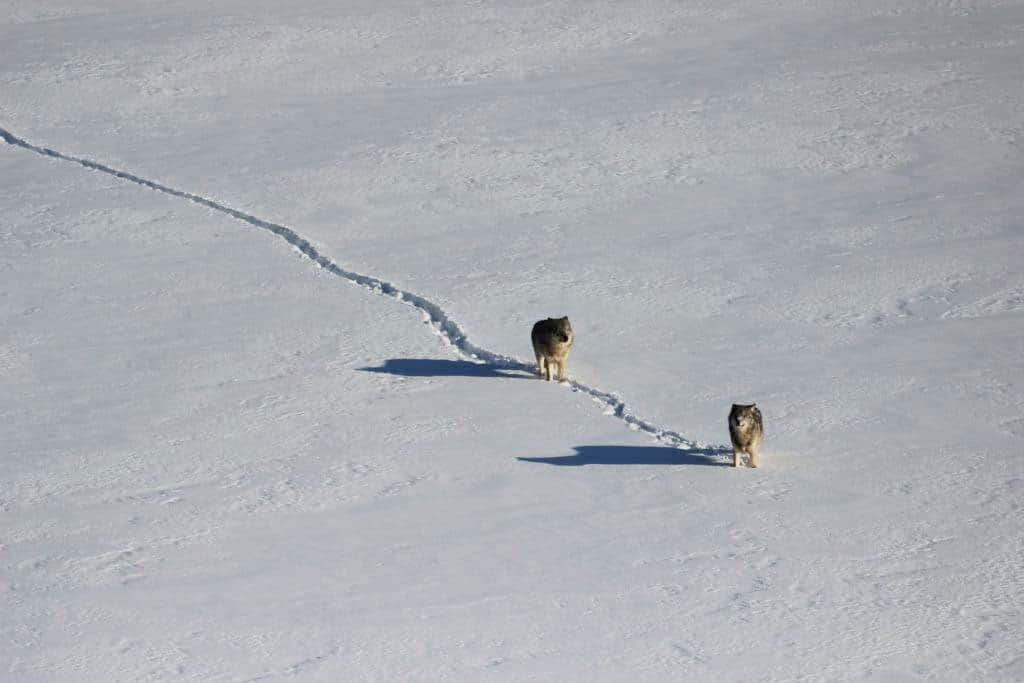
Isle Royale National Park superintendent Phyllis Green announced last week that the park and partners are almost ready to start trapping wolves and and transporting the predators to the island in Lake Superior. The effort is being undertaken in response to the decline of the National Park’s wolf pack to near zero, and a resulting boom in the moose population.
The action comes after years of debate about the merits of meddling in the National Park’s ecosystem, which is also a federally-designated wilderness area. There are concerns that an unchecked moose population could drastically change the park’s forest, and that climate change could reduce the chances an ice bridge will form that could let wolves naturally return. The park is also the location of a long-running study of the predator-prey relationship that connects moose and wolves.
Biologists studying the park’s moose say the population is increasing on average 16 percent each year, and could double in size within four to five years without intervention, according to the Detroit Free Press.
Some environmental and wilderness advocates have objected to the project, but the National Parks Conservation Association is supportive, seeking to preserve special qualities of the park.
“Today we learned the National Park Service’s plans for the first phase of wolf introduction at Isle Royale National Park,” said Lynn McClure, Senior Regional Director for National Parks Conservation Association. “While six wolves for this first phase may not be as many as people expected this year, we appreciate the multi-agency, science-based plan that we know to be thorough and diligent. And we support their efforts to ensure a success for the island, it’s ecosystem, the wildlife and all who visit this national park.”
Administrators decided in June that they would seek to reintroduce 20-30 wolves to the park over the next three to five years. Now the first phase of the plan is in motion, as up to six wolves from Minnesota and Michigan will be trapped, examined, and then taken to the island over the next six to eight weeks.
Trap, examine, transport, release
Wolves from the Grand Portage Reservation in Cook County, Minnesota and from the Upper Peninsula of Michigan will be trapped and moved to the island. Ontario wolves could be included in the future.
“This phase of the operation will transport two to four wolves trapped in Minnesota and up to two wolves from Michigan to Isle Royale by amphibious aircraft or boat,” the National Park Service stated. “All wolves transferred to the island would undergo a health screening by a wildlife veterinarian to determine suitability, and will be collared with GPS collars.”
Biologists will trap wolves and select healthy animals between the ages of one to five years, to get wolves in their prime reproductive state to help repopulate the island, the Associated Press reported. They will also look for clear eyes and strong canine teeth, to ensure they can kill and eat moose. Wolves suffering ailments such as bone fractures, missing limbs, heartworm, and mange will be excluded, and the biologists will seek to ensure the selected wolves are comprised equally of males and females.
Dr. Seth Moore, director of wildlife and biology for the Grand Portage Band of Lake Superior Chippewa, told WTIP in Grand Marais that there are about five wolf packs currently living on reservation lands. The band hopes that removing some of the wolves from tribal lands may actually help the beleaguered moose population, which has been declining for several years across northern Minnesota.
Monitor, study, educate
Throughout the reintroduction project, the Park Service plans to monitor predation rates, genetics, moose-wolf ratios, and terrestrial and aquatic vegetation impacts. The Park Service is also developing new education programs to improve understanding of the reintroduction effort, and has invited researchers to propose new projects to study the wolf reintroduction and its impacts on the ecosystem.
While the operation is being led by Isle Royale National Park, the effort is requiring support from at least 30 partners, including airplane pilots, trappers, land managers in Minnesota and Michigan, and others.
Partner agencies and organizations include the Grand Portage Band of Lake Superior Chippewa, Michigan Department of Natural Resources, Minnesota Department of Natural Resources, U.S. Fish & Wildlife Service, USDA Wildlife Services, U.S. Geological Survey, University of Minnesota, and NPS units in Montana, Colorado, Nevada and Florida, NPS Midwest Regional Office, Washington Office and Biological Resources Division.

